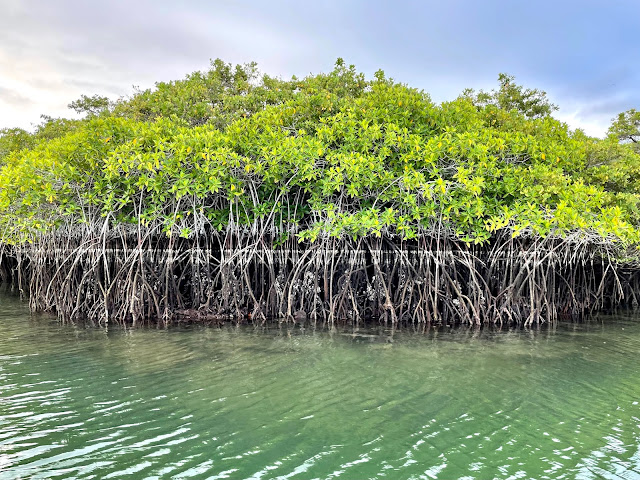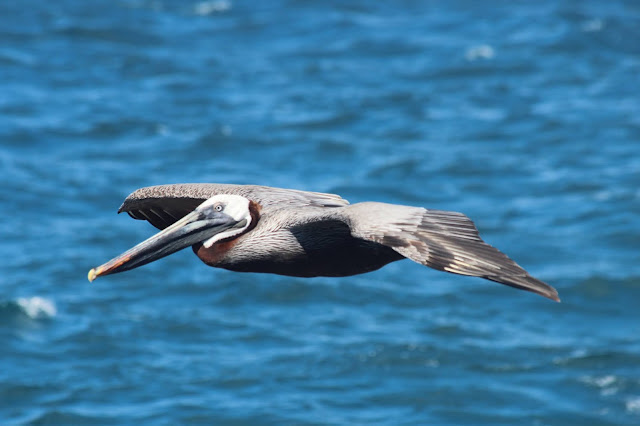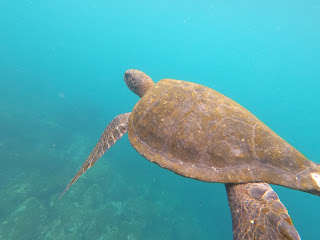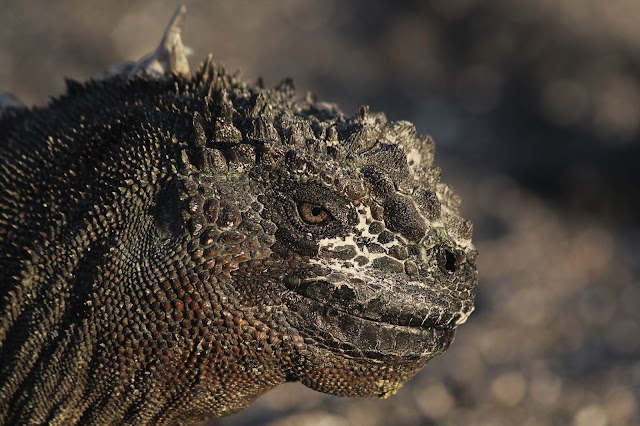August 1: Baltra and Santa Cruz Islands
First day in the Galápagos!! We flew in to Baltra, the site of an airport that was once a US Air Force base during WWII charged with protecting the Panama Canal. Immediately after deplaning, while walking into the terminal, we saw a land iguana - a fun way to start the trip. A short bus ride took us to the harbor where we waited for zodiacs to take us onto the National Geographic Islander. While we were waiting, we saw sea lions, pelicans, blue footed boobies, and even an octopus swimming in the water!!
The first thing we did is have lunch on board, which (in true Lindblad fashion), was delicious and plentiful. The staff is so nice and welcoming, and so far the other guests have been great as well. The ship is smaller than most of the other in the Lindblad fleet, with a passenger capacity of 48 - but there are only 26 passengers on this voyage. And that includes a big family of 14, and 6 GTF guests! That means the naturalist to guest ratio is much smaller than on a traditional expedition, so hopefully we'll get amazing opportunities to see wildlife.
The excursion for the day was a zodiac cruise on the northern shore of Santa Cruz Island, in a secluded mangrove forest called Black Turtle Cove. Because of the protection provided by the roots of the mangroves, the shore along the beach is a wonderfully sheltered place for sea turtles and baby sharks. We saw several - black tipped reef sharks and pacific green sea turtles, along with puffer fish, damsel fish (with yellow tails and lips), and jumping mullet. Since we departed at around 4PM, we had lovely light and the tide was extremely low - which means we could easily see several sea turtles and baby black tipped reef sharks swimming in the water.
The bird sightings here were remarkable! We saw cattle egrets, lava heron, great grey heron, brown pelicans, blue footed boobies, yellow finch, ground finch, and surprisingly, a black-crowned night heron. Once thought of as endemic, the black crowned night heron was demoted when they realized it could be found in other places in South America.
The term 'mangrove' doesn't mean a specific type of plant - it refers to several plants that live in this ecosystem. Mangroves are marsh plants that have the ability to filter salt water, and creep outwards with their roots thereby building up the shoreline. Silt and sand build up in the root system, providing a rich environment for other organisms. On the roots of the white and red mangroves in this cove, we even saw small oysters.
 |
| I spy... a baby shark! |
August 2: North Seymore and Rabida Islands
An early morning excursion took us to the northern shore of North Seymore Island, an unpopulated island that is one of the most important fishing and nesting sites for sea birds, and we visited the rookery on the open nesting grounds among a Palo Santo forest.
It was amazing to see so many unafraid - some even curious - blue footed boobies, frigate birds, split tailed gulls, and lava gulls. The boobies literally nest on the ground, pooping on the soil to mark their territories. They generally raise just one chick; often, when two eggs are laid, they will give priority to one (and essentially use the other as a backup in case the first doesn't make it). These baby birds were SO fluffy, and constantly hungry!
Frigate bird babies are just as floofy, with goofy looks on their faces. Meanwhile, the adult males do their best to attract female attention.
Sea birds also included Nazca boobies, Oystercatchers, Swallowtail gulls, and pelicans.
During lunch, we sailed to the small island of Rabida. It's known for the red sand beach, and we tested out our snorkling from the shore. Many sea turtles, a couple sea lion swim-bys, and a huge white tipped reef shark!

We also noticed right away that there were a lot of green sea turtles and iguanas in the water. We also saw several sea lions, penguins, and a Galápagos hawk. In a small sheltered cove, a Pacific Green Sea Turtle had come up to rest on the beach, and several flightless cormorants were sunning themselves.

After snorkeling, we had a short hike to see the island. Back in 1975, the National Park Services eradicated all the introduced goats, and now are trying to get rid of the introduced black and Norwegian rats. Eventually, they hope to bring it back to its original ecosystem. One interesting thing we saw was a Galápagos tomato plant. There are lots of endemic cacti and scrubby Palo Santo trees, and the soil is a rich red color because of the iron oxide and magnesium in the lava, which rusts as it is exposed to the air.
Aug 3: Isabela and Fernandina Islands
After an early AM stretching session on the sun deck, we ate a hearty breakfast. In the mid-morning, the ship traveled north and crossed back over the equator! It was apparent the environment is different - here is where the deep frigid waters of the Equatorial Counter-current rises up along the western edge of the undersea Galápagos Platform. It makes for a very rich underwater ecosystem.
First went on zodiac ride around Punta Vicente Roca, on the 'chin' of Isla Isabela. Saw a small colony of fur seals - two got into a huge fight, fell off the rocks, and got pretty bloodied up.
Soon after, we went deep water snorkeling off the zodiacs - it was a great place, and we saw a bunch of sea turtles and sea lions in the water with us. And on the zodiac ride in, we saw several mola molas and even a baby hammerhead shark!!
After lunch, we sailed to Punta Espinoza on Fernandina Island, the only island in the world with no introduced species. Fernandina is the youngest of the Galápagos Islands, only 300 thousand years old and still volcanically active.
The area we hiked was covered in pahoehoe lava, where a population of large marine iguanas were basking.
We also noticed right away that there were a lot of green sea turtles and iguanas in the water. We also saw several sea lions, penguins, and a Galápagos hawk. In a small sheltered cove, a Pacific Green Sea Turtle had come up to rest on the beach, and several flightless cormorants were sunning themselves.
These birds adapted to their food source being underwater, so they are amazing swimmers and divers - and have lost the ability to fly.
BBQ dinner and afterwards we went to the sky deck for stargazing. Instead, we looked into the dark water and could very easily see several schools of fish, darting around as though being chased. Then some sea lions appeared, and we heard lots of splashing. But soon after, we noticed a different shape chasing after them - turned out to be a fairly large white-tipped reef shark!!! So cool to see it all at night!
 |
| The glittering emerald eyes of the flightless cormorant |
BBQ dinner and afterwards we went to the sky deck for stargazing. Instead, we looked into the dark water and could very easily see several schools of fish, darting around as though being chased. Then some sea lions appeared, and we heard lots of splashing. But soon after, we noticed a different shape chasing after them - turned out to be a fairly large white-tipped reef shark!!! So cool to see it all at night!




















No comments:
Post a Comment